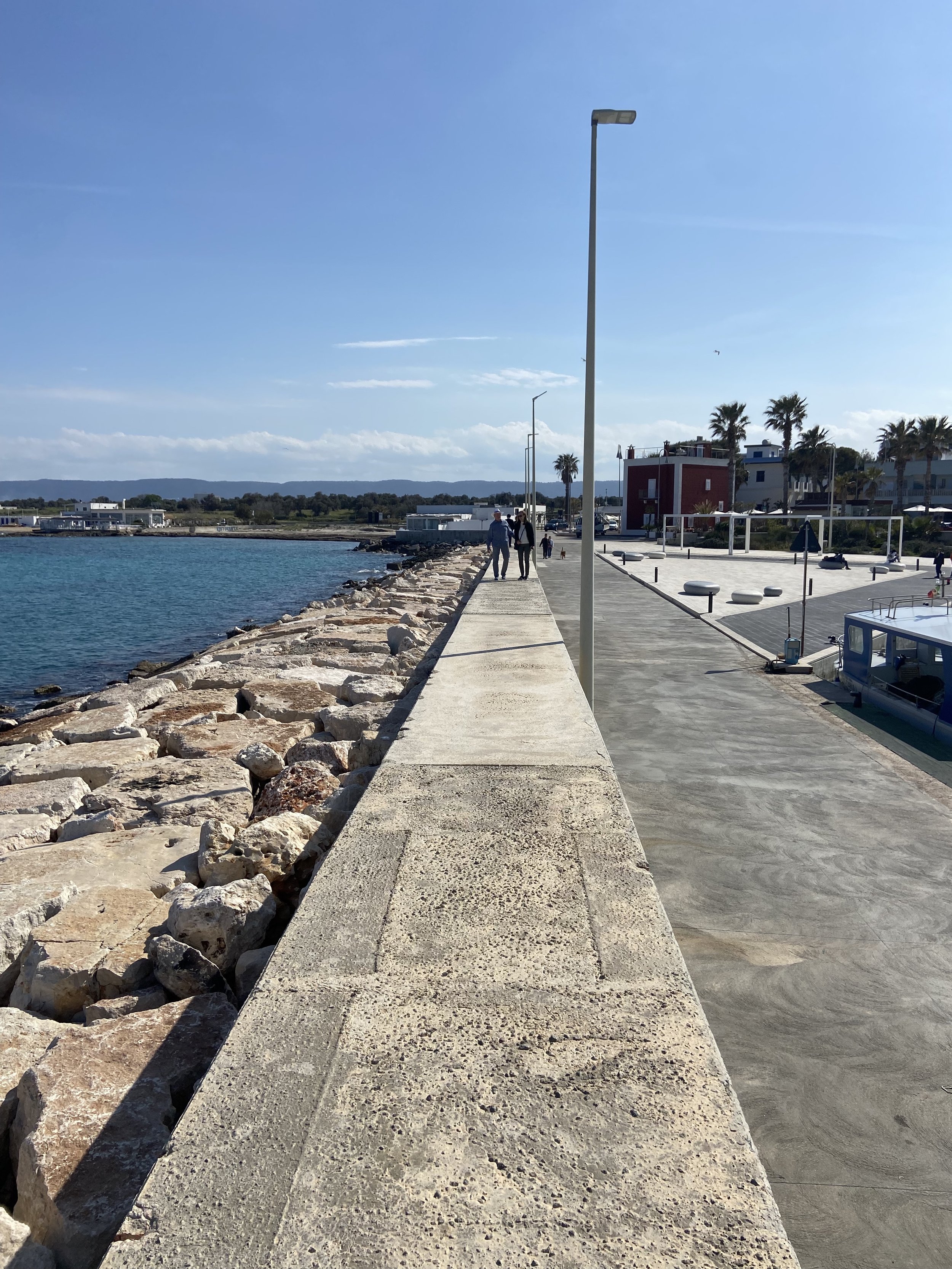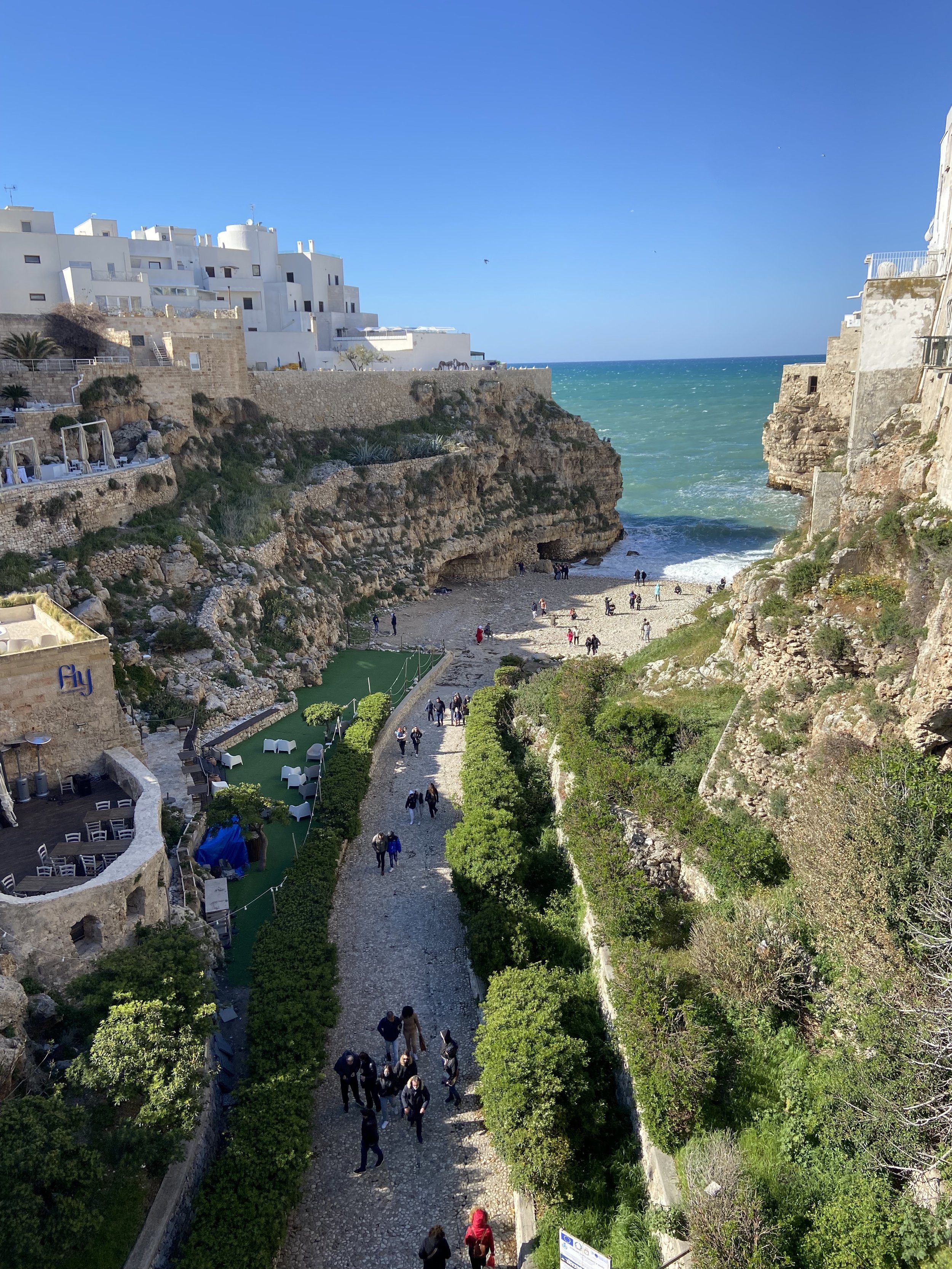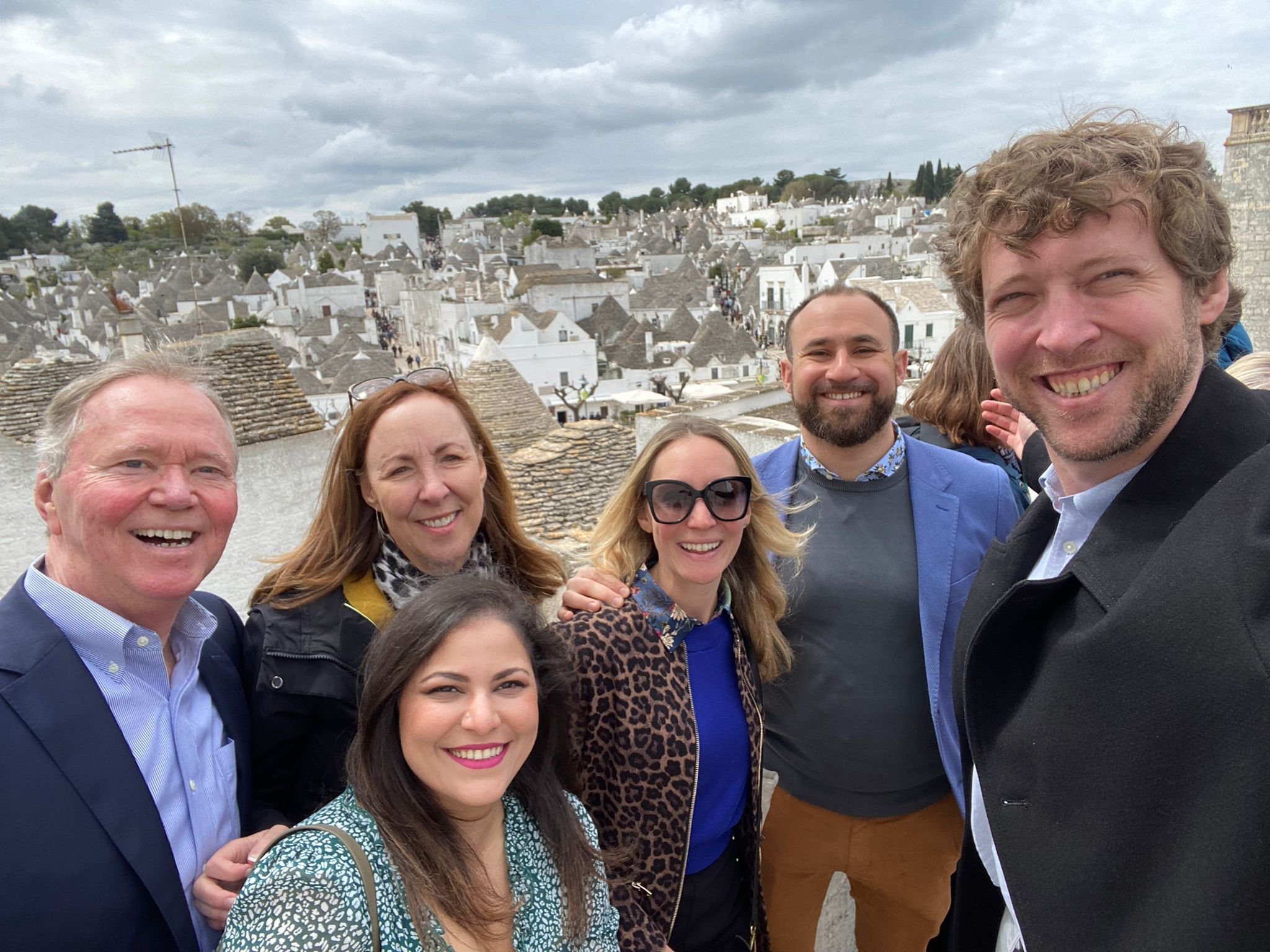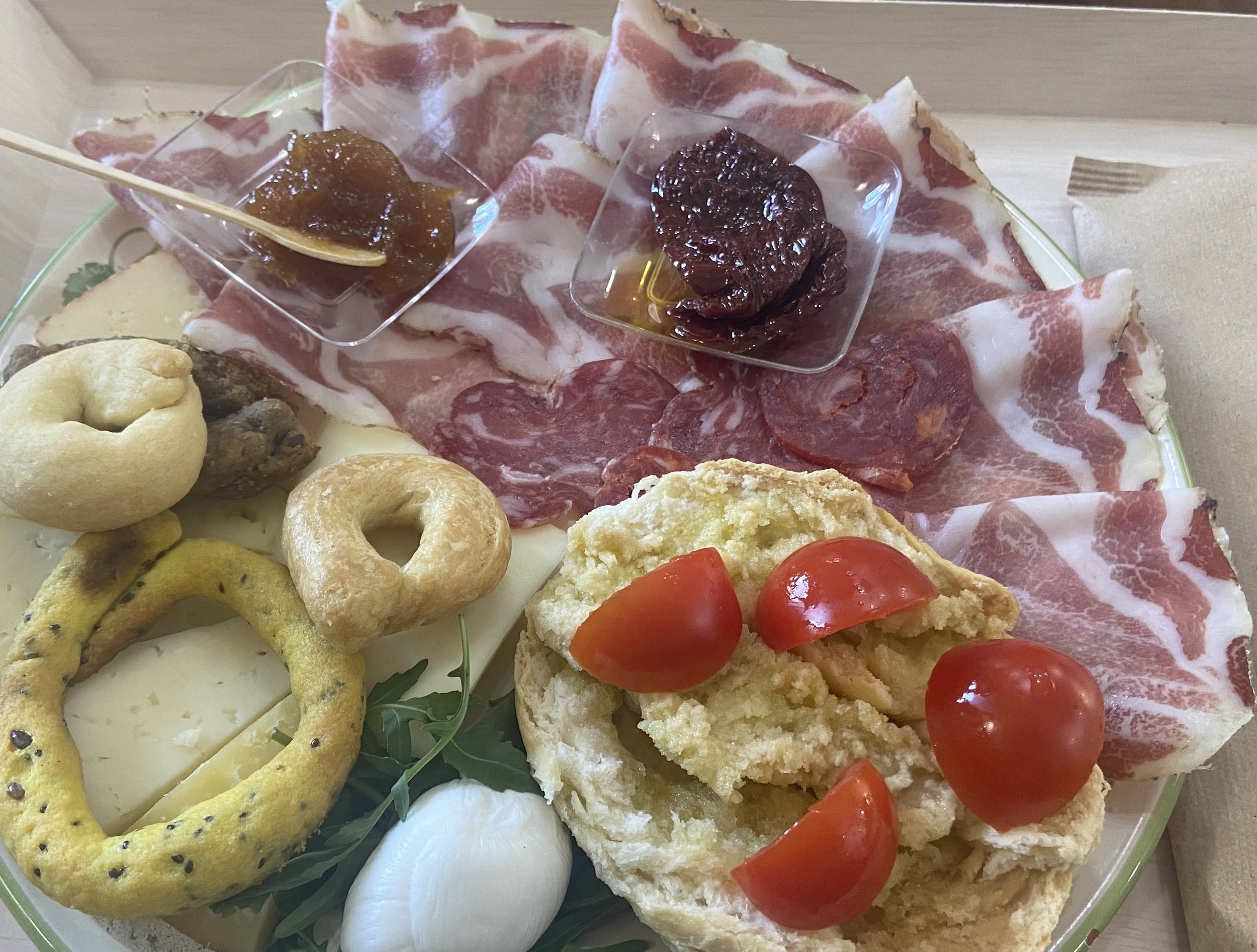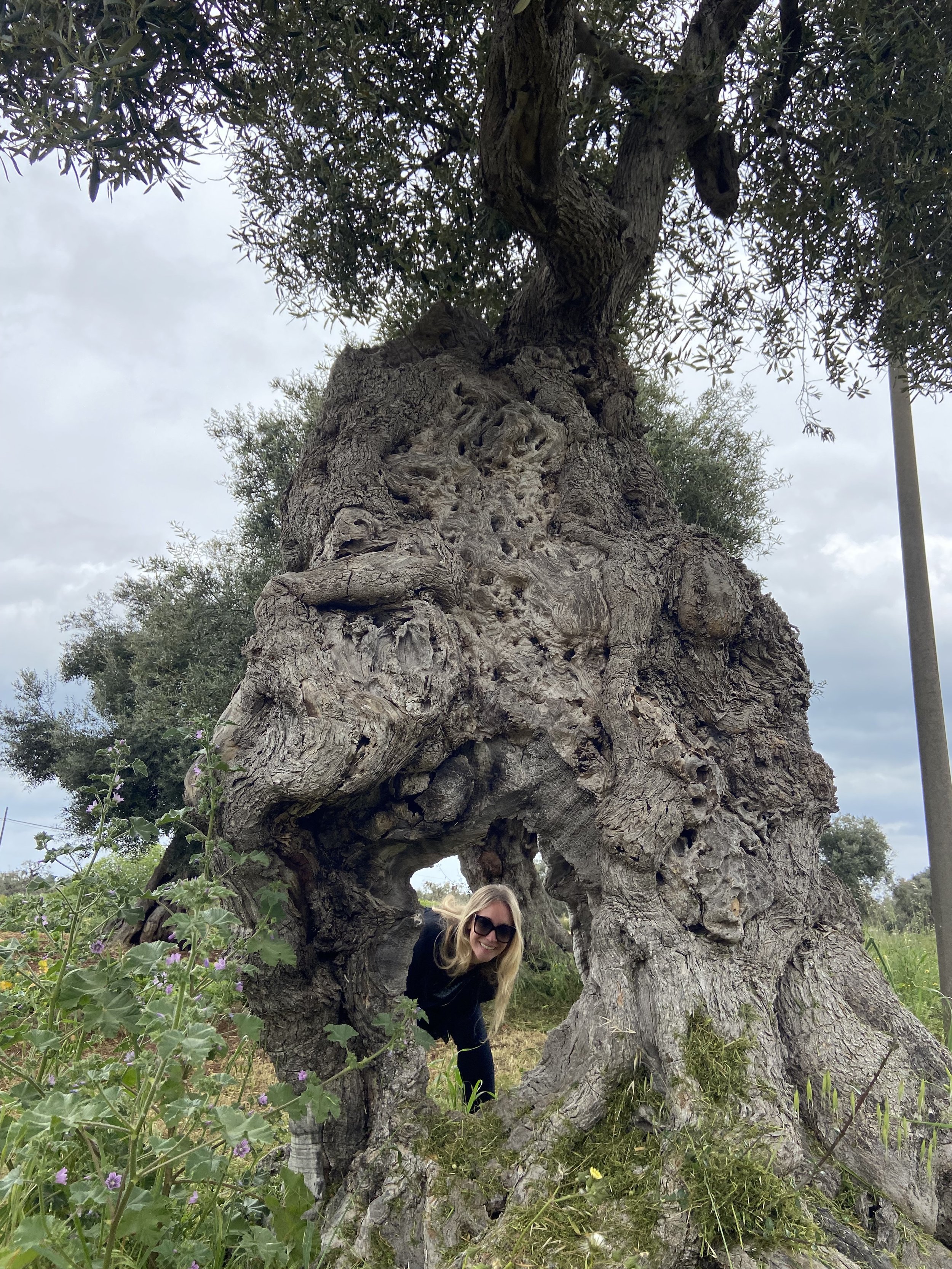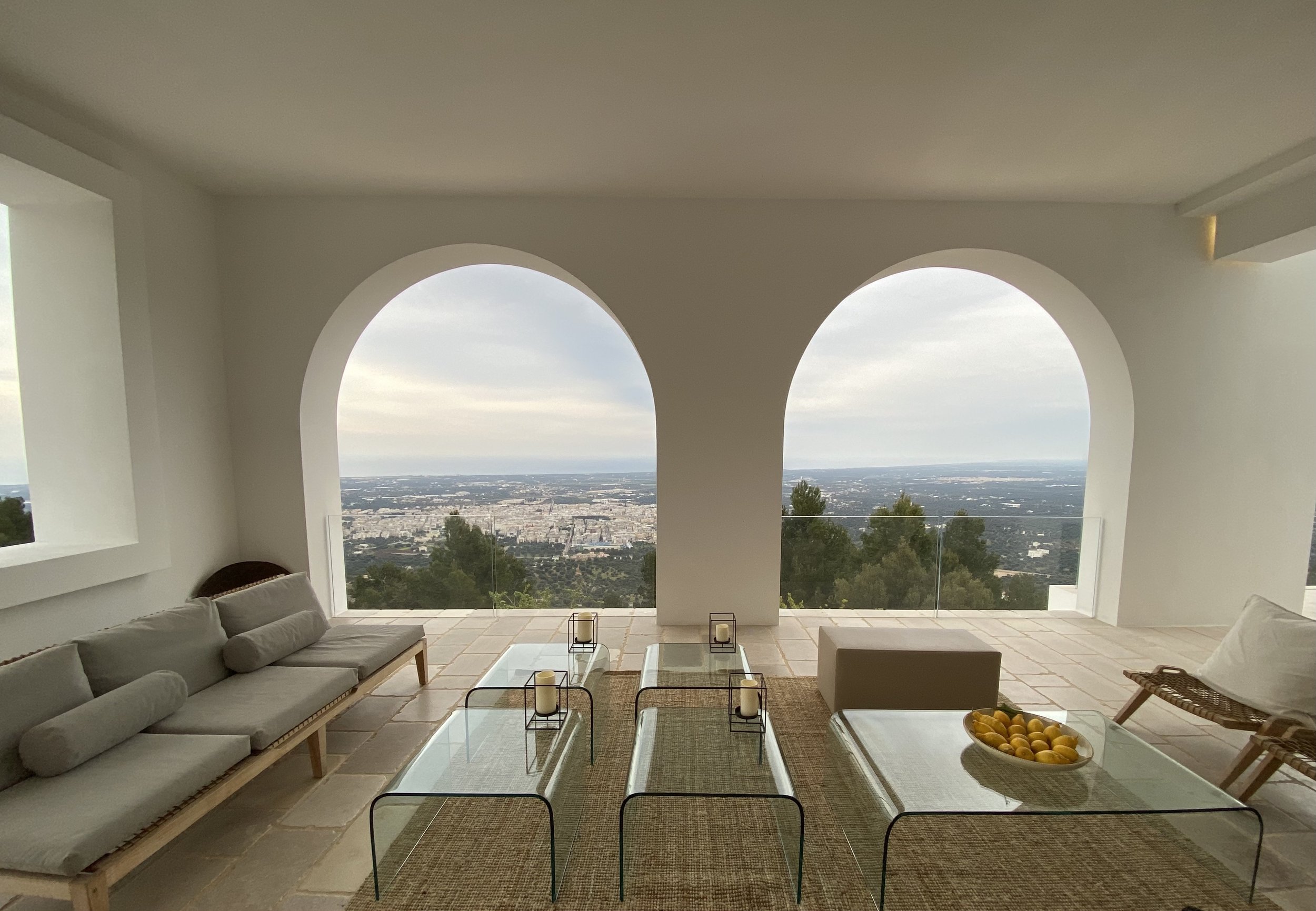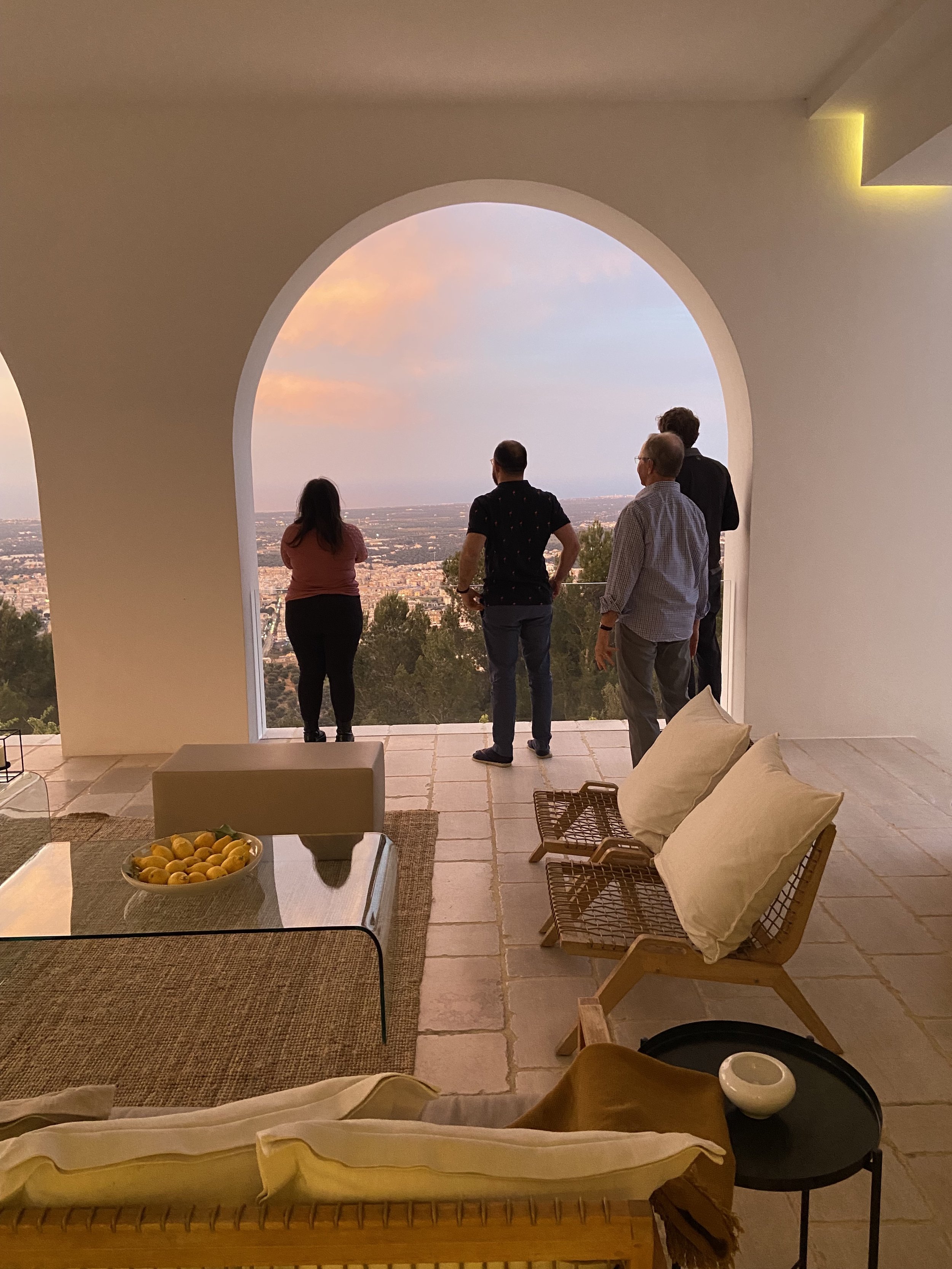Regional Features in the Valle d’Itria and on the Neighboring Coast of Central Puglia
Ostuni
Ostuni, “La Citta Bianca”, (The White City), was a highlight and surprise of my 2022 trip to Puglia. The town is elevated on a hill, about 8 KM from the Adriatic coastline, but the predominance of brilliant white buildings gives it the striking appearance and thus the romantic sobriquet to accompany it.
Get lost in the chalky white labyrinthine interior streets. Take steps, take pictures and take it all in. You will no doubt have a blissful wandering here, not much more direction needed.
Make a Lunch or Dinner Res at Osteria Del Tempo Perso. The interior of the restaurant is one of the most distinctive (and frankly, the coolest) I have experienced in Italy. As explained on their website, the restaurant is built into the rock and it feels like you are eating in an inland ‘grotta’ (grotto) from the 1500s. The fare is Puglian with some special twists and takes, but everything was very tasty. Two types of Orecchiette (the ‘little ear’ pasta, the most famous type in the region) graced our table.
For a second course, we tried the ‘bombette’ , a regional specialty, that are little rolls of meat stuffed with cheese and pancetta. In fact, it was an Easter lunch that we ate here, so we indulged in antipasti, primi, secondi and dolci. The restaurant even sent us home with extra goodies, a chocolate egg for Easter, a showing of the excellent hospitality you can find in southern regions of Italy.
Visit the cathedral. The Duomo di Ostuni, also known as the Basilica concattedrale di Santa Maria Assunta, has foundations that hark back to 1000. The striking rose window is from the 15th century, and in fact, the church was rebuilt in the gothic style after the debilitating earthquake that struck southern Italy in 1456. The duomo stands as a commanding presence and you will no doubt encounter it, looming over the historical center with the particular Arco Scoppa directly in front.
I decided to merge recommendations for the following towns in, and in the vicinity of, the Valle d’Itria. I believe that each pairing has interesting commonalities, and you might want to choose one over the other depending on your travel style, budget, and if you are pressed for time. If time is no issue, of course, I would recommend that you visit them all!
Savelletri (Fasano) and Polignano a Mare
Here are two seaside options in the Itria Valley area of Puglia. For fewer crowds and fewer € head to Savelletri. For a more instagrammable experience, Polignano might be your siren call!
Savelletri (Fasano)
Eat at Pescheria 2 Mari in Savelletri. Savelletri does not have quite the reputation, or, the same level of spectacular views as Polignano a Mare, to be honest. What it does have is this restaurant with unbelievably fresh fish, much lower prices, and fewer tourists. Pescheria 2 Mari is by no means ‘cheap and cheerful’ fare, although the quality is worth the price and the atmosphere is lovely. The restaurant has a nice outdoor terrace, very close to the water for a stroll after, and good wine to pair.
Take a stroll out onto the rocky piers in Savelletri. Once leaving Pescheria 2 Mari, you are a stone’s throw from the rocky pier that extends out over the small port. Walk out on the pier and then continue your stroll in the direction of the Molo di Ponente. You will pass understated beach front properties lining the harbor area. Stay for a spritz in one of the establishments lining the harbor, if you have the time.
Polignano a Mare
Eating in the Grotta Palazzese will probably be a once in a lifetime experience for most. It is one of the first restaurants that I can remember truly reaching a level of ‘Instagram fame’ (now a rather common phenomenon around the world). On a special trip with my family, we splurged and indulged in the experience. The food, while good, was not Michelin star quality but is sold at Michelin star prices. The atmosphere, however, is something else.
In April, it was chilly while literally eating in an open air sea cave with water rushing below. The staff kindly brought us blankets, and we bundled up to enjoy the experience of a lifetime.
Take a Stroll in Polignano all along the perimeter of the town overlooking the water. Even if you do not splurge for a meal at the ‘Grotta’, the instagrammable seafront promenade (the lungomare) is worth some attention. Walk to the panoramic viewpoint at Largo Ardito and snap a shot back over the buildings on sheer rocky cliffs over the sea. We did not visit during the summer season, so swimming was not on the books. However, we did walk over to view the famous Lama Monachile beach (also called Cala Porto). It attracts crowds in the summer, but you will see why. On your ‘passeggiata’ (stroll) over to this beach, I encourage you to explore the streets of the town center, there are cute interior passageways as well. I don’t want to undersell Polignano a Mare; this ‘city on the sea’ has become so popular for a reason, of course.
Alberobello and Martina Franca
These are two towns with distinctive architectural structures to take in. Both towns boast larger ‘claims to fame’ in the region, so you might find crowds. Still, if you are exploring the Valle d’Itria by car, they are worth a stop at least.
Alberobello
Visit the iconic Trulli of Alberobello. Alberobello has the UNESCO designation, and although as the website explains, these unique structures are constructed through a ‘prehistoric building technique’ the earliest trulli date from ‘only’ the 14th century. Thus, although aesthetically striking, the trulli are not ‘truly’ ancient like one might assume without poking around the internet for a little history. Still, they have undoubtably become one of the symbols of the region, and the sheer number of them grouped together (over 1500) in Alberobello make the town worth a stop. You will not be alone, however, as even when I visited in April of 2022, I found Alberobello to be overwhelmed with visitors. A wonderful elevated viewpoint (where we did wait our turn and snap the family picture above) was flooded.
Thus, my advice here would be, go, explore, take some pictures, but do not stay too long. I found some restaurants that looked good, however; namely, you could eat at Ristorante EVO or Ristorante Trullo D’Oro. We didn’t visit during lunch or dinnertime, and personally, I am happy with that decision. If you happen to be there at a mealtime, try them out!
Martina Franca
Visit the Baroque churches in Martina Franca, which, I found, to be much calmer around Easter time in 2022. There are architectural gems to explore here too, but they represent the 18th century, and the Baroque style. Even more specifically, the Baroque architecture here is known as the ‘Martinese Baroque’. If you continue your journey in Puglia and explore the Salento region (the featured city of Lecce, for example) you will meet the Baroque again (although with slight differences). The Basilica of San Martino is worthy of exploration on the interior and exterior. The 17th century Palazzo Ducale is also worth a gander, as is the 18th century Porta Santo Stefano which will lead you into the charming city center.
Eat at Ristorante Torre di Angelucco. Again, we didn’t visit the town during a mealtime, and so I did not try the restaurant myself. I had done the research in case we did. It comes highly recommended, and was even featured on the popular Italian TV show 4 Ristoranti. Also, be sure to eat or buy capocollo in Martina Franca! While you are in this area of Puglia you will no doubt see Capocollo di Martina Franca on menus and in shop windows galore. Well, this town is the namesake! Capocollo is a cut of meat from near the neck of the pigs raised in this region. There is a delicacy and sweetness to Capocollo that makes it so popular. In fact, to protect and maintain the quality, the Capocollo di Martina Franca is a part of the “Slow Food” movement. Of course, what better place to procure it than Martina Franca!
Cisternino and Locorotondo
What to do in these two cute, rather similar, little towns in the Valle d’Itria? Enjoy! Walk around, observe; there are so many wonderful alleyways, corners, unique perspectives to capture on film or in your imagination. Then, of course, visit one of these restaurants both of which I can personally vouch for and highly recommend. We opted to visit both of these towns in the evening in order to try some of the local restaurants in each one. Again, if you are pressed for time, choose one or the other.
Cisternino
Eat at Enoteca Il Cucco in Cisternino. As you might have seen on other posts, this recommendation came from the App dedicated to natural wine called Raisin. This enoteca is also a bottle shop, so you can browse the selection and choose a bottle to drink at your table or go by the glass. All the food is fresh with attention to quality and seasonal ingredients. There is a lovely terrace for evening meals in the warmer months. As this restaurant is located just slightly outside of the true city center, take an after dinner stroll to aid digestion (following Italian tradition) to get the full picture.
The residents and local government of Cisternino have taken care to make their town particularly photogenic for you. Well taken care of plotted plants and vibrant flowers line the streets with fun quotations scattered around waiting to be appreciated by visitors.
Locorotondo
Eat at Osteria Il Rosone in Locorotondo. This is a really cute, delicious, local restaurant in this really cute, quaint local town. The pictures on their website and Google do not do the interior decoration justice in my opinion. The service was attentive and personable; in fact, the restaurant is family run as it says by ‘Margherita and Peppino’ on their website.
Once you have finished exit the restaurant to find Via Morelli, keep walking until you find the striking Baroque doorway of Palazzo Morelli, a sight to behold. As in most Italian towns you will find a Villa Comunale (this is the local public park). Take a stroll and admire the views over the landscape in the Itria Valley.
Bonus Experiences in the Valle d’Itria
Visit (or stay in) a Masseria. A masseria is often defined as a large ‘fortified’ farmhouse. Why ‘fortified’? Well, many were constructed as early as the 16th century, when a defense system would have been needed to protect from intruders. Nobles would have owned the properties and there would have been stables, land, of course, accommodation for those working on the farms in addition to the quarters for the wealthy owners. There are TONS of ‘masserie’ in the Itria Valley. In fact, I recommend another wonderful masseria called Croce Piccola in the Food and Wine post for Puglia. The masseria pictured above is Masseria Garrappa which we visited for a fun and useful cooking class.
We were given dough to try our hand (and knife!) at the famous pasta shapes from the region, namely, orecchiette and cavatelli. We aided in the process of making the Foccaccia Barese (the name comes from the important town of Bari, though you might also hear Foccaccia Pugliese in general), doused in high quality EVOO with local olives and wilted tomatoes bursting with flavor atop. Of course we were able to eat our creations, with the help of the more skilled Pugliese nonne (grandmothers) assisting us.
Visit (or stay in) a Trullo, the conical symbol of this area as mentioned many times in this post. It is worth experiencing one up close and personal. There are many ways to do this. We ate at the Orto restaurant (Orto Ristorante Naturale is the full name, with ‘orto’ meaning ‘garden’ in Italian). The restaurant is a part of the Nina Trulli Resort. As stated in the name, you can stay here, if your budget and interest allows. The grounds are tranquil and picturesque. We opted just to dine in as we had accommodations elsewhere. The food is particularly fresh and often grown on the grounds. You will pass through extensive gardens on the property where ingredients are sourced from. You can opt for a la carte options or a tasting menu (linked is a sample menu from their website). This intimate restaurant is Michelin recommended, and the attention to detail, personal touches, and impeccable quality make Orto one of my highest recommendations for a special experience in the Itria Valley.
We used The Thinking Traveller for divine accommodation in this region of Puglia. Our villa and home for the week had elevated sweeping views over Fasano, reaching towards the sea. However, as explained above, there are so many masserie or even trulli (you can find these on Airbnb as well) that you can explore to find the perfect accommodation for your tastes and budget.






